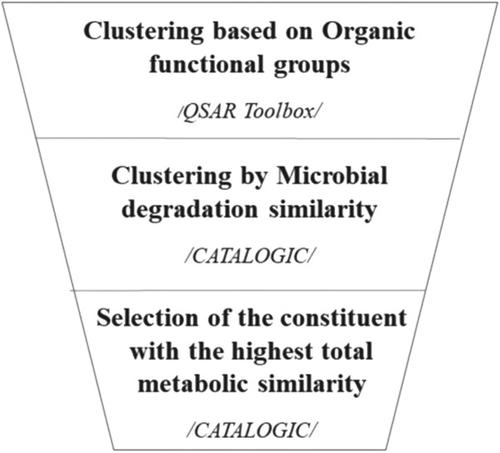当前位置:
X-MOL 学术
›
Environ. Toxicol. Chem.
›
论文详情
Our official English website, www.x-mol.net, welcomes your feedback! (Note: you will need to create a separate account there.)
Selection of Representative Constituents for Unknown, Variable, Complex, or Biological Origin Substance Assessment Based on Hierarchical Clustering
Environmental Toxicology and Chemistry ( IF 4.1 ) Pub Date : 2021-09-09 , DOI: 10.1002/etc.5206 Darina G Yordanova 1 , Timothy J Patterson 2 , Colin M North 3 , Louise Camenzuli 4 , Atanas S Chapkanov 1 , Todor S Pavlov 1 , Ovanes G Mekenyan 1
Environmental Toxicology and Chemistry ( IF 4.1 ) Pub Date : 2021-09-09 , DOI: 10.1002/etc.5206 Darina G Yordanova 1 , Timothy J Patterson 2 , Colin M North 3 , Louise Camenzuli 4 , Atanas S Chapkanov 1 , Todor S Pavlov 1 , Ovanes G Mekenyan 1
Affiliation

|
Many of the newly produced and registered substances are complex mixtures or substances of unknown or variable composition, complex reaction products, and biological materials (UVCBs). The latter often consist of a large number of constituents, some of them difficult-to-identify constituents, which complicates their (eco)toxicological assessment. In the present study, through a series of examples, different scenarios for selection of representatives via hierarchical clustering of UVCB constituents are exemplified. Hierarchical clustering allows grouping of the individual chemicals into small sets, where the constituents are similar to each other with respect to more than one criterion. To this end, various similarity criteria and approaches for selection of representatives are developed and analyzed. Two types of selection are addressed: (1) selection of the most “conservative” constituents, which could be also used to support prioritization of UVCBs for evaluation, and (2) obtaining of a small set of chemical representatives that covers the structural and metabolic diversity of the whole target UVCBs or a mixture that can then be evaluated for their environmental and (eco)toxicological properties. The first step is to generate all plausible UVCB or mixture constituents. It was found that the appropriate approach for selecting representative constituents depends on the target endpoint and physicochemical parameters affecting the endpoint of interest. Environ Toxicol Chem 2021;40:3205–3218. © 2021 SETAC
中文翻译:

基于层次聚类的未知、可变、复杂或生物来源物质评估的代表性成分选择
许多新生产和注册的物质是复杂的混合物或未知或可变成分的物质、复杂的反应产物和生物材料(UVCBs)。后者通常由大量成分组成,其中一些成分难以识别,这使其(生态)毒理学评估变得复杂。在本研究中,通过一系列示例,举例说明了通过 UVCB 成分的层次聚类选择代表的不同场景。分层聚类允许将单个化学品分组为小集合,其中成分在多个标准方面彼此相似。为此,开发和分析了用于选择代表的各种相似性标准和方法。解决了两种类型的选择:(1) 选择最“保守”的成分,这也可用于支持对 UVCB 进行评估的优先顺序,以及 (2) 获得涵盖整个目标 UVCB 的结构和代谢多样性的一小组化学代表或然后可以评估其环境和(生态)毒理学特性的混合物。第一步是生成所有可能的 UVCB 或混合物成分。发现选择代表性成分的适当方法取决于目标终点和影响目标终点的物理化学参数。(2) 获得一小组涵盖整个目标 UVCB 或混合物的结构和代谢多样性的化学代表,然后可以评估其环境和(生态)毒理学特性。第一步是生成所有可能的 UVCB 或混合物成分。发现选择代表性成分的适当方法取决于目标终点和影响目标终点的物理化学参数。(2) 获得一小组涵盖整个目标 UVCB 或混合物的结构和代谢多样性的化学代表,然后可以评估其环境和(生态)毒理学特性。第一步是生成所有可能的 UVCB 或混合物成分。发现选择代表性成分的适当方法取决于目标终点和影响目标终点的物理化学参数。环境毒物化学2021;40:3205–3218。© 2021 SETAC
更新日期:2021-10-27
中文翻译:

基于层次聚类的未知、可变、复杂或生物来源物质评估的代表性成分选择
许多新生产和注册的物质是复杂的混合物或未知或可变成分的物质、复杂的反应产物和生物材料(UVCBs)。后者通常由大量成分组成,其中一些成分难以识别,这使其(生态)毒理学评估变得复杂。在本研究中,通过一系列示例,举例说明了通过 UVCB 成分的层次聚类选择代表的不同场景。分层聚类允许将单个化学品分组为小集合,其中成分在多个标准方面彼此相似。为此,开发和分析了用于选择代表的各种相似性标准和方法。解决了两种类型的选择:(1) 选择最“保守”的成分,这也可用于支持对 UVCB 进行评估的优先顺序,以及 (2) 获得涵盖整个目标 UVCB 的结构和代谢多样性的一小组化学代表或然后可以评估其环境和(生态)毒理学特性的混合物。第一步是生成所有可能的 UVCB 或混合物成分。发现选择代表性成分的适当方法取决于目标终点和影响目标终点的物理化学参数。(2) 获得一小组涵盖整个目标 UVCB 或混合物的结构和代谢多样性的化学代表,然后可以评估其环境和(生态)毒理学特性。第一步是生成所有可能的 UVCB 或混合物成分。发现选择代表性成分的适当方法取决于目标终点和影响目标终点的物理化学参数。(2) 获得一小组涵盖整个目标 UVCB 或混合物的结构和代谢多样性的化学代表,然后可以评估其环境和(生态)毒理学特性。第一步是生成所有可能的 UVCB 或混合物成分。发现选择代表性成分的适当方法取决于目标终点和影响目标终点的物理化学参数。环境毒物化学2021;40:3205–3218。© 2021 SETAC



























 京公网安备 11010802027423号
京公网安备 11010802027423号